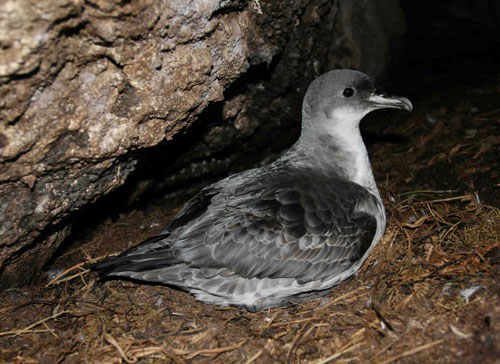Prince Edward Island, smaller of the two sub-Antarctic islands in the South African Prince Edward Island Group, is rarely visited in an effort to retain its near-pristine nature. However, a six-person party is scheduled to visit the island next month as part of the annual relief of the meteorological and research station on the larger Marion Island.
Research on ACAP-listed species on Prince Edward over a period of six days (the maximum length of visit allowed for by the Prince Edward Islands Management Committee) will be led by Azwianewi Makhado of the Department of Environmental Affair's Marine and Coastal Management Branch.
Major research initiatives will include completing a survey commenced in December 2008 (click here) of the distribution and numbers of burrows of the White-chinned Petrel Procellaria aequinoctialis, which, with surveys already made on Marion Island, should result in an estimate of the island group's total annual breeding population. At the same time, burrows of the winter-breeding Grey Petrel P. cinerea will be searched for and counted. This species is rare on Marion Island, but is thought to be more abundant on Prince Edward, where until now it has remained unstudied.
Counts of occupied nests of surface-nesting albatrosses of five species, including of the Wandering Albatross Diomedea exulans (which will then have small chicks) will be undertaken over the whole island. It is also intended to attach satellite transmitters (PTTs) on up to 10 Indian Yellow-nosed Albatrosses Thalassarche carteri to ascertain their at-sea movements during the late chick-rearing stage and after breeding during the winter months. This species does not breed on Marion Island so can only be studied within the group at Prince Edward.
In addition to the MCM party, a team of three from the Centre of Excellence for Invasion Biology (CIB), Stellenbosch University will undertake surveys of the distribution of alien plants and invertebrates. The CIB team will include ACAP's Information Officer, who in the guise of an amateur historian will be visiting and making a photographic record of the largely undisturbed sealers' sites on the island.

A selected bibliography of ACAP-listed species at Prince Edward Island
Berruti, A., Griffiths, A.M., Imber, M.J., Schramm, M. & Sinclair, J.C. 1981. The status of seabirds at Prince Edward Island. South African Journal of Antarctic Research 10/11: 31-32.
Cooper, J. & Brooke, M. de L. 1984. Breeding status of burrowing petrels at Prince Edward Island. South African Journal of Antarctic Research 14: 34-35.
Imber, M.J. 1983. The lesser petrels of Antipodes Islands with notes from Prince Edward and Gough Islands. Notornis 30: 283-298.
Ryan, P.G., Cooper, J., Dyer, B.M., Underhill, L.G., Crawford, R,J.M. & Bester, M.N. 2003. Counts of surface-nesting seabirds breeding at sub-Antarctic Prince Edward Island, summer 2001/02. African Journal of Marine Science 25: 441-451.
Ryan, P.G., Jones, M.G.W., Dyer, B.M., Upfold, L. & Crawford, R.J.M. 2009. Recent population estimates and trends in numbers of albatrosses and giant petrels at the sub-Antarctic Prince Edward Islands. African Journal of Marine Science 31: 409-417.
John Cooper, ACAP Information Officer, 6 March 2010

 Français
Français  English
English  Español
Español